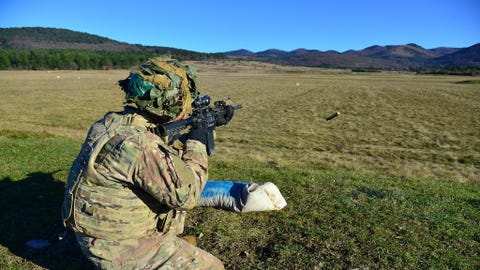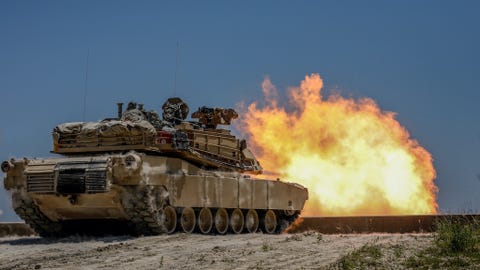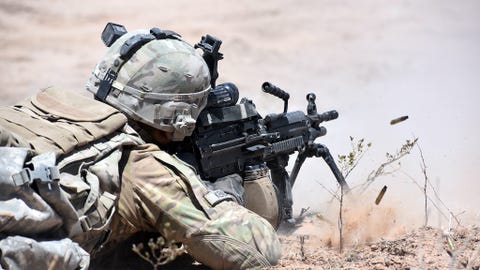The Army’s Next Infantry Guns Will Have Computerized Fire Control for Unreal Accuracy
Next generation infantry weapons will incorporate computer technology previously only available on tanks.
By Kyle Mizokami PAOLO BOVO, DVIDS
PAOLO BOVO, DVIDSThe U.S. Army’s next assault rifle and machine gun will have built-in computers to give soldiers unparalleled firing accuracy. The so-called Next Generation Squad Weapons will feature a digital fire control system borrowing many features from today’s main battle tanks, allowing shooters to engage targets faster and with greater precision than their opponents can muster.
The Army’s Next Generation Squad Weapons (NGSW) program aims to field two new advanced weapons: the NGSW-Automatic Rifle (NGSW-AR) and the NGSW-Rifle. NGSW-AR will replace the M249 squad automatic weapon, while NGSW-Rifle will replace the M4 carbine. A typical nine-soldier U.S. Army infantry squad is armed with two M249s and seven M4 carbines.
So far, very little is known about either new weapon, other than that the firearms will feature a new 6.8-millimeter round, use a new lightweight ammunition system, and feature a reduced “ acoustic and flash signature.” Now we know one more detail: Both weapons will feature high tech ballistic computers giving soldiers increased battlefield accuracy.

Computerized fire control allows tanks such as the M1A2 Abrams to have a high first round hit probability at distances of over a mile.
MAJOR CARSON PETRY, DVIDS
In the 1970s, tanks began to receive computer-based fire control systems designed to increase accuracy at long range. Basic physics tells us that a projectile fired from a tank gun is immediately affected by gravity and will eventually crash into the ground. Firing many rounds under controlled conditions can allow engineers to predict how fast and far a projectile can travel. Provided with this data, a gunner can make minute adjustments to achieve greater accuracy, such as raising the tank gun barrel slightly to compensate for the effects of gravity.
In the real world of training and combat, there are other considerations. Wind can blow projectiles slightly off target, and the temperature of the barrel (after it is warmed by previous shots) can also affect a projectile’s path. Even the age of the barrel can affect accuracy. The new ballistic computers allowed tanks to automatically intake information such as target range, wind speed, barrel life, and the number of shots fired and make instantaneous corrections, allowing for dramatically improved first round accuracy. The M1A2 Abrams, for example, is reportedly capable of 90 percent first round hit capability on an enemy moving tank at 1.2 miles.
The same issues that plague tank guns also affect individual soldier's weapons, including infantry carbines and squad automatic weapons. A ballistic computer for soldiers has always been possible, but the physical size of the electronics package and power requirements meant only multi-ton tanks and infantry fighting vehicles could carry them.

Trackingpoint rifle with computerized optic.
GETTY IMAGES
Moore’s Law, plus the rapid pace of electronics miniaturization, has changed everything. In 2013, TrackingPoint released a Linux-powered ballistic computer for civilian shooters that greatly increased accuracy by using a laser to determine range to target. This information allowed the ballistic computer to then anticipate the bullet’s slow but inexorable drop due to gravity and advise the shooter where to aim to strike the target.
According to Military.com, the Next Generation Squad Weapons will feature ballistic computers that will “will calculate all of the environmental [conditions] automatically,” including distance, wind speed, and other factors. The computer can then project an adjusted aiming point onto the soldier’s field of vision—whether it be a weapon-mounted optic, goggles, or helmet-mounted monocle—allowing the soldier to hit his target quickly and efficiently. The use of the latter could even allow soldiers to point their weapons around corners or from behind other forms of cover, aiming them via a wireless link without exposing themselves to enemy fire.

M249 Squad Automatic Weapon.
WINIFRED BROWN/DVIDS
The NGSW weapons will seamlessly incorporate ballistic computers while rugged and capable of surviving the rigors of combat. They must incorporate sensors such as wind readers, shot counters, and laser rangefinders. They must do all this while remaining relatively lightweight: the the M4 carbine weighs only seven pounds, and add-ons can alter the balance and feel of the weapon, in addition to making them unwieldy on long marches and patrols.
If the Army can produce a reliable, lightweight system it could greatly increase infantry weapon accuracy, especially for the NGSW-Automatic Rifle. Automatic rifles are designed to provide suppressive fire against enemy targets to allow friendly forces the ability to maneuver. A computer-aided automatic rifle could engage enemies more quickly at longer ranges and with fewer shots. All of this could make the U.S. Army of the 2020s dramatically more lethal than the Army of just ten years before.
No comments:
Post a Comment